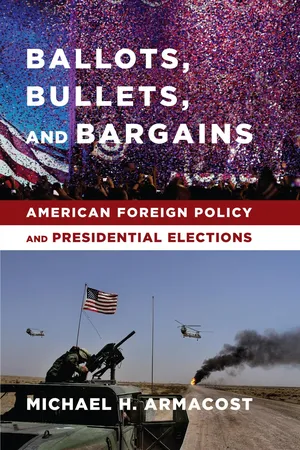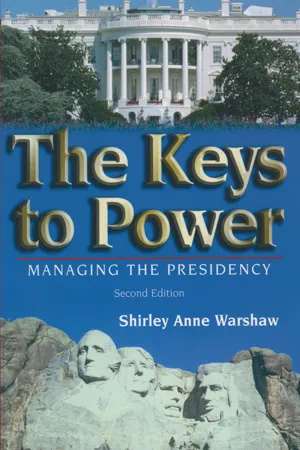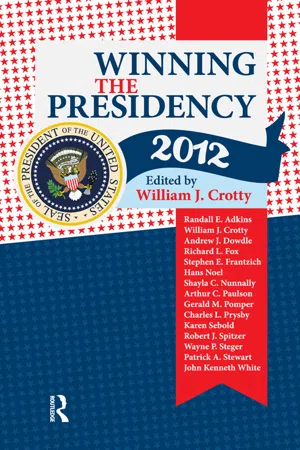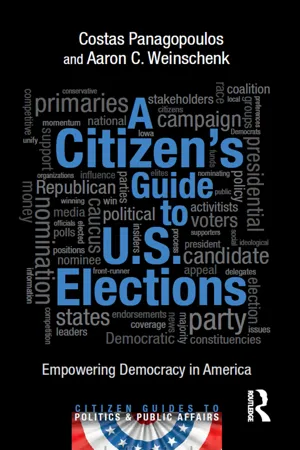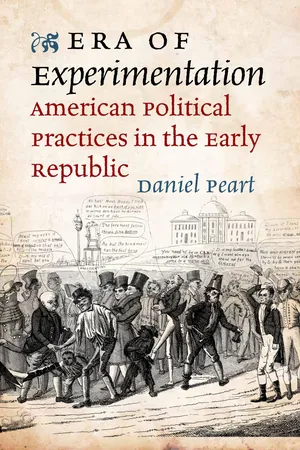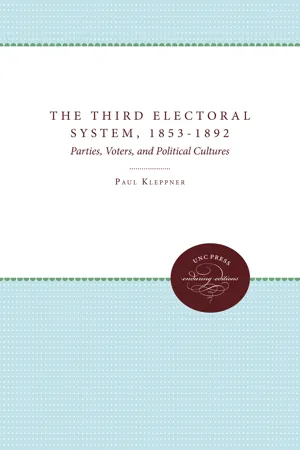History
1824 Presidential Election
The Presidential Election of 1824 was a significant event in American history marked by a contentious and controversial outcome. It was the first election in which the popular vote did not directly determine the winner, leading to a "corrupt bargain" between John Quincy Adams and Henry Clay. This election ultimately contributed to the formation of the Democratic Party and the beginning of the modern two-party system in the United States.
Written by Perlego with AI-assistance
Related key terms
6 Key excerpts on "1824 Presidential Election"
- eBook - ePub
Ballots, Bullets, and Bargains
American Foreign Policy and Presidential Elections
- Michael Armacost(Author)
- 2015(Publication Date)
- Columbia University Press(Publisher)
1 ELECTIONS, PARTIES, AND POLITICSBEFORE ADDRESSING THE IMPACT OF THE AMERICAN PRESIDENTIAL election system on the conduct of foreign policy, it is necessary to review some of the central features of that system. Its fundamental contours, set by the Constitution, are stable and rarely change. But the customs and conventions of political life, and the party competition that drives our elections, are constantly in flux. Hence, this primer on where things stand in the wake of the 2012 election.CONSTITUTIONAL RULESSince passage of the Twelfth Amendment in 1804, candidates for president, along with their vice presidential selection, run on a single party ticket. They are the only political leaders whose electoral fate depends on a national constituency and who can legitimately claim a national political mandate. They may not be residents of the same state.1We elect our presidents for a fixed term. Presidential elections are held on the first Tuesday in November every fourth year. No provision in the Constitution allows for holding a presidential election early, or for delaying it in the face of, say, a national or international crisis. Despite the bitter contention over the Florida outcome in the 2000 election, no do-over was possible because the election date is fixed by the Constitution. Hence, the courts addressed only whether and how to manage recounts.Candidates for the presidency must be natural-born citizens. Thus California’s Austrian-born former governor, Arnold Schwarzenegger, is ineligible, as are all naturalized citizens. But individuals born abroad may be eligible to become a candidate if at least one parent had met U.S. residency requirements.None can be younger than thirty-five, a provision that is much less restrictive today than in the days of our Founding Fathers, when life expectancy was much shorter.Since passage of the Twenty-second Amendment in 1951, no president is permitted to serve for more than two terms. If a vice president (or someone else in the established line of presidential succession) inherits the office as a result of the death, infirmity, resignation, or impeachment of an incumbent during the last two years of his term, he may run twice for reelection. - eBook - ePub
The Keys to Power
Managing the Presidency
- Shirley Anne Warshaw(Author)
- 2015(Publication Date)
- Routledge(Publisher)
Throughout the nation’s history, only five elections, four in the 1800s and one in 2000, have been controversial once the votes were counted. All other elections have produced a clear winner. The first two controversial elections (1800 and 1824) failed to produce a winner who had a majority of electoral votes. The problem was the result of multiple candidates on the ballot, each with substantial popular support, who split the electoral vote. In these two elections, the House of Representatives was required to choose the president. In the third, fourth, and fifth controversial elections (1876, 1888, and 2000), the winner of the electoral vote was not the winner of the popular vote.The Election of 1800
The first controversial election was the election of 1800, in which neither of the two leading candidates, incumbent John Adams nor challenger Thomas Jefferson, received a majority of the electoral vote. A tie vote occurred between Jefferson and his vice presidential candidate, Aaron Burr, each receiving 73 votes. Adams received only 65 votes. Adams’s running mate, Charles Pinckney of South Carolina, received 64 votes. In the absence of either Jefferson or Burr having a majority of electoral votes, the Constitution (Article II, Section 1, paragraph 2) required the election to be decided by the House of Representatives. Each state, according to the Constitution, had one vote.TABLE 2.2Controversial ElectionsYear Winner Loser Issue 1800 Thomas Jefferson Aaron Burr Neither candidate received a majority of the electoral vote; decided in House. 1824 John Quincy Adams Andrew Jackson Neither candidate received a majority of the electoral vote; decided in House. 1876 Rutherford B. Hayes Samuel Tilden Evidence of voter fraud; decided by a special electoral commission 1888 Benjamin Harrison Grover Cleveland Cleveland won the popular vote but not a majority of the electoral college. 2000 George W. Bush - eBook - ePub
- William J. Crotty(Author)
- 2015(Publication Date)
- Routledge(Publisher)
Today’s political distemper is not explained by personal attitudes and behavior alone. We are living with a party system that over the past half century has become ideologically polarized by standards of the American experience. This is the party system that shaped the election of 2012, as it has most presidential elections since 1964, and will shape nomination and election campaigns for the foreseeable future.For the Democrats in 2012, the renomination of President Obama was ensured. But the internal dynamics of the Republican Party were on display. This chapter first discusses electoral change and the development of the polarized party system in American politics, and then applies the discussion to the emergence of today’s Republican Party and the Republican presidential nomination of2012.Parties and Factions in American Politics
The United States has had a two-party system for almost the life of the republic, although that system has been a dynamic one, going through periods of fundamental change. Party and electoral change have been widely illustrated using the concept of realignment , introduced by V. O. Key (1955, 1959) and developed most notably by Walter Dean Burnham (1970). Realignment involves significant and persistent shifts in the electoral coalitions of our major parties, which tend to occur periodically, often resulting in new majority parties, governing coalitions, and policy agendas (Andersen 1976, 1979; Bartels 1998, 2000; Burnham 1991, 1996; Clubb, Flanigan, and Zingale 1990; Ladd 1978; Ladd with Hadley 1978; Lawrence 1997; Arthur Paulson 2000, 2007a, 2007b, 2009, 2012; Pomper 1972, 1996; Pomper with Lederman 1980; Speel 1998; Stonecash 2006; Sundquist 1983). Critical realignments have been placed in the 1830s, the 1860s, the 1890s, the 1930s, and, more controversially, the 1960s. From this perspective, the sixth party system emerged in the 1960s (Aldrich and Niemi 1996).American political parties are best understood when examined as factional systems. Across all alignments until the 1960s, the major parties were umbrella parties, loose coalitions among interests and factions, each spanning the ideological spectrum (Aldrich 1995; Beck and Sorauf 1992; Mayer 1996; Arthur Paulson 2000, 2007a, 2009, 2012; Polsby 1978; Rae 1989, 1994, 1998; Schneider 1978). The Republicans, generally more conservative on economic issues, were also the party of “modern” values and more liberal on racial issues. The Democrats, more progressive on economic issues, were also the party of “traditional” values, and on balance more conservative on racial issues, if only because of their southern white supremacist faction (Jensen 1978; Arthur Paulson 2000, 2007a, 2009, 2012). Supported by cross-cutting coalitions, both parties spanned the ideological spectrum. - eBook - ePub
A Citizen's Guide to U.S. Elections
Empowering Democracy in America
- Costas Panagopoulos, Aaron C. Weinschenk(Authors)
- 2015(Publication Date)
- Routledge(Publisher)
4 PRESIDENTIAL ELECTIONSEvery four years, U.S. presidential elections generate considerable media attention, excitement, and debate. Even people who aren’t normally all that interested in politics often become engaged because of all of the “hoopla” surrounding the election. Campaign advertisements fill the airwaves (at least in some places); candidates crisscross the country making campaign stops in many states; pollsters constantly survey the American electorate to learn which candidate is in the lead; and media outlets report on each candidate’s every move. It is hard to avoid politics during presidential election years, especially if one lives in a state that the campaigns view as being “up for grabs.” Given the importance of the presidency in the United States, it is not surprising that presidential elections typically attract higher levels of voter participation than congressional midterm, state, or local elections. Despite the prominence of presidential elections, many Americans find some features of our electoral system to be confusing and, at times, frustrating. In this chapter, we focus on three important aspects of the presidential election process—the selection of candidates, the role of the Electoral College, and the factors that influence election outcomes.The Selection of Presidential Nominees
For many people, the most interesting aspect of presidential elections is the candidate pool. Who are the candidates among whom voters will get to choose? Unlike local elections, which often attract candidates with little experience in politics, presidential elections typically draw candidates who have significant previous experience in government as well as national reputations. In the 2012 election, for example, Barack Obama had previously served as a U.S. senator and Mitt Romney had previously served as the governor of Massachusetts and was the runner-up for the Republican nomination in the previous presidential contest in 2008. As presidential campaigns unfold, most people develop at least some familiarity with the candidates, but many people do not have a clear understanding of how the candidates are selected. In part, this is probably due to the fact that the selection process takes place over an extended period of time. Although the presidential nominating conventions are technically the place where the candidates are officially chosen, the selection process begins long before the conventions are held. - eBook - ePub
Era of Experimentation
American Political Practices in the Early Republic
- Daniel Peart(Author)
- 2014(Publication Date)
- University of Virginia Press(Publisher)
4
“YOU MUST ORGANIZEAGAINST ORGANIZATION”
The Presidential Election of 1824
Written during the canvass by John C. Calhoun, himself a candidate for the White House, the following appraisal of the presidential election of 1824 presents a stark contrast to the standard celebratory narrative, which paints political parties as agents of democracy:It cannot be doubted that a party has grown up in our country, who aspire to the government of the Union, not th[r]ough the confidence and attachment of the people, but by a dextrous use of what is called party machinery. The great object of the party has been to enlist in its cause political leaders, who were supposed to possess a control over the machinery and in this it has succeed[ed] to a great extent. They are now struggling to give to this machinery the highest possible force.1In the eyes of most modern scholars, the emergence of mass parties signaled the dawning of the Age of the Common Man. To Calhoun, however, the rise of party portended something else entirely: government of the politicians, by the politicians, for the politicians.The object of Calhoun’s ire was William H. Crawford. Crawford and those that backed his bid for the presidency sought to make the campaign a referendum on the proper role of party in a republican polity. In their hands, they contended, party would be an organ of good government, facilitating the rule of the majority and restraining the improper ambition of individuals. But this vision did not go unchallenged. Crawford’s rivals united to condemn his version of party as a tool for self-serving politicians, while defending their own right to organize in opposition. In this chapter, then, as in chapter 1 , we see that neither partisanship nor antipartisanship is as monolithic as they sometimes appear.The 1824 election also provides a lesson in the motives of these early party builders. Scholars have suggested that parties were created to serve three main functions: to engage and mobilize a mass electorate; to translate popular preferences into legislative outcomes; and to regulate access to public office.2 In chapter 2 the opponents of slavery demonstrated that nonpartisan organizations were capable of performing the first of these functions, and in chapter 3 - eBook - ePub
The Third Electoral System, 1853-1892
Parties, Voters, and Political Cultures
- Paul Kleppner(Author)
- 2017(Publication Date)
- The University of North Carolina Press(Publisher)
Each burst of electoral reorganization has produced a discrete party system. Each party system has shared common elements with the others, but each has also displayed its own “characteristic patterns of voting behavior, of elite and institutional relationships, and of broad system-dominant decisions.” 5 Viewed across time, American electoral politics have witnessed no fewer than five national party systems. The first party system, from 1789 to about 1820, was marked by an experimental, hesitant, sometimes nonpurposive, and never fully successful groping toward the creation of durable partisan structures. It might more properly be termed a pre party party system. The second party system, from 1828 to the realignment of the 1850s, grew from a host of local political alignments; it was characterized, inter alia, by a fully nationwide two-party competition. The third party system, or the Civil War party system, from 1853 to 1892, emerged from the collapse of one of the major parties, the breakdown of nationwide partisan competition, and the reorientation of both the party system and its policies along explicitly sectional lines. The fourth party system, from 1893 to about 1932, emerged from the incapacity of the third system to accommodate the emergent demands of the cash-crop agrarians of the South and the West coupled with the onset of an urban-industrial depression in early 1893. Unlike the other party systems, this one was characterized by the absence of viable partisan competition both at the national level and in a majority of the states. It was marked, too, by a steep decline in the high rates of voter mobilization that had been a hallmark of the third electoral era. Finally, the fifth party system, or the New Deal party system, resulted from the depression and realignment of the 1930s
Learn about this page
Index pages curate the most relevant extracts from our library of academic textbooks. They’ve been created using an in-house natural language model (NLM), each adding context and meaning to key research topics.
